Listen, if you’re tired of those flimsy plastic boards that shed tiny particles into your meals or the warped wood ones that make chopping a hassle, grab a Caraway cutting board set today.
Crafted from sustainable birch wood without any harmful chemicals, these boards make every slice feel effortless and safe. You’ll wonder how you ever cooked without them—your knives stay sharp, your counter stays clean, and your food tastes purer.
Trust me, once you switch, there’s no going back.
My Hands-On Time With The Caraway Cutting Board Set
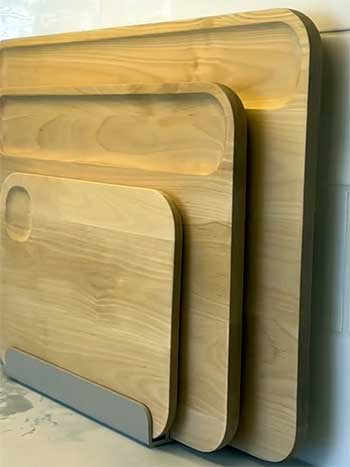
The box showed up on a Tuesday, and I ripped it open like a kid on Christmas. Inside: three birch beauties—small (10×7 inches), medium (14×10), and large (17×12)—plus a slim carbon steel rack.
No plastic wrap, just clean packaging that matched my sage Caraway pans.
I ran my fingers over the smooth, mineral-oiled surface and felt the weight—solid but not back-breaking.
First task: conditioning. I rubbed in the included oil, let it soak overnight, and woke up to boards that smelled faintly of woodshop in the best way.
Breakfast called—medium board, avocado toast. My knife slid through like butter, no drag, no flecks.
I flipped to the indented side, dropped chopped cilantro in the wells, and it stayed put while I scrambled eggs. No chasing herbs across the counter.
Lunch meant chicken on the large board. Post-roast, juices pooled perfectly in the groove—no lake on my counter. Handles made flipping it to the sink effortless. The small one handled afternoon cheese and apples; compact, stable, perfect for quick bites.
By dinner, I was prepping stir-fry. Medium for veggies, large for proteins—kept raw chicken separate, zero cross-contamination stress. The rack dried them upright, airflow on point. A week in, I used the large as charcuterie for friends; flipped to the clean side, it stole the show.
I pushed limits: sweet potatoes, onions, crusty bread with a serrated blade. Faint lines appeared, but nothing deep. Hot soapy rinse, towel pat, rack dry—no warping, no smells.
The set lives on my counter now; partner grabs the small for late snacks, kids “help” on the medium. Chopping feels fun again, not a chore. If your old boards frustrate you, this trio fixes it fast.
What I Love Most: The Pros of Caraway Cutting Boards
Switching to Caraway boards transformed my routine, and breaking it down, the upsides are what keep me reaching for them every time.
Let me walk you through what stands out when you’re in the thick of meal prep, because you deserve tools that make life easier, not more complicated.
- Eco-Friendly Build That Feels Good
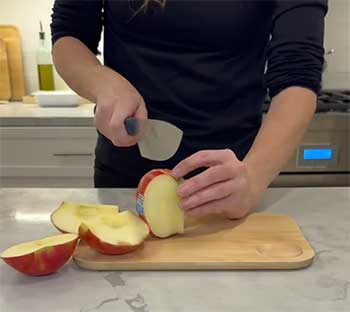
You ever pick up a cutting board and think, “This thing’s probably leaching who-knows-what into my food”?
Not with Caraway.
Made from FSC-certified birch wood, these are sustainably sourced—no deforestation guilt here.
The finish is food-safe mineral oil and wax, skipping plastics entirely.
I feel better knowing I’m not adding microplastics to my stir-fries or salads. It’s that quiet win: chopping mindfully, for the planet and my plate.
Plus, birch is naturally antimicrobial, so bacteria don’t stand a chance. After prepping garlic-heavy marinades, a rinse and dry leaves it fresh—no funky odors clinging on.
- Versatility Across Sizes and Tasks
One board? Boring. This set gives you three—small for quick fruit slices, medium for everyday proteins, large for feast-mode meal prep. The double-sided design shines: one side flat for broad chopping, the other with juice grooves to trap messy liquids from roasts or watermelons.
Those recessed indents?
Game-changers. Drop in diced veggies or pair with Caraway’s storage containers—they hold steady without sliding off. I’ve turned the large into a charcuterie base mid-party, flipping to the unmarked side for serving. You adapt it to your flow, whether solo breakfast or family taco night.
- Knife-Kindness That Saves Your Blades
Remember when your knives went dull after a few uses on rough surfaces? Caraway’s edge-grain birch is gentle—the wood fibers give just enough without scarring your edges. My chef’s knife slices tomatoes paper-thin now, weeks in, without resharpening as often. It’s like the board whispers, “Go ahead, cut harder.”
No more that grating resistance on plastic or the splintery feel of cheap bamboo. If you’re investing in good blades, this protects that spend. I tested with everything from paring to serrated, and it holds steady, keeping your toolkit sharp longer.
- Sleek Storage and Counter Appeal
Clutter drives me nuts—who wants boards stacked haphazardly in a drawer? The included rack is slim, carbon steel, and props them upright for airflow drying. It tucks neatly on my counter, boards visible but organized.
Colors match Caraway’s line—cream, sage, terracotta—so it elevates your space. Guests notice; it’s not just functional, it’s a subtle style flex. And at 1.5 inches thick, they’re stable without being back-breaking to lift.
Lightweight enough for quick grabs, hefty for no-slip chopping.
- Durability Meets Everyday Ease
These aren’t fragile showpieces. Birch resists warping better than softer woods I’ve tried, even in steamy dishwater proximity (though I hand-wash, as advised). After heavy use—think weekly roasts and veggie marathons—no cracks or bows.
The wax finish repels stains initially, buying you time before deep cleans. They’re built for your real life: kid spills, hurried dicing, late-night snacks. That reliability? It frees your mind to focus on flavors, not fixes.
Maintenance Tips For Caraway Cutting Board
Now, let’s talk care—because even the best boards need love to last. I learned this the hard way with past ones that cracked from neglect. With Caraway, it’s straightforward, but consistent habits pay off big.
Follow these, and yours will look new years from now. I’ll share what works in my kitchen, so you can skip the trial-and-error.
- Daily Cleaning: Quick and Gentle
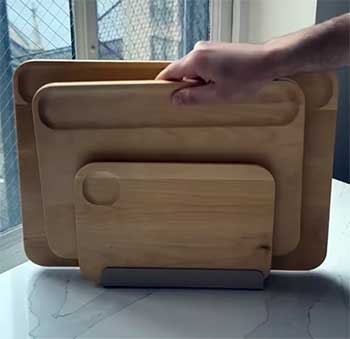
After every use, hit it with hot, soapy water—mild dish soap, no abrasives that scratch the wood.
I use a sponge, scrub lightly in circles, focusing on cut marks where bits hide.
Rinse thoroughly; soap residue invites bacteria.
Never soak—water swells the grain, leading to splits.
Pat dry with a towel, then prop upright in the rack for air circulation.
Takes two minutes, but prevents that musty smell. For raw meats, I sprinkle coarse salt, scrub with a lemon half—the acidity kills germs naturally, leaving a fresh scent.
You do this, and cross-contamination worries vanish.
- Oiling Routine: Your Monthly Ritual
Oiling seals the wood, keeping it hydrated and stain-resistant. Start with the included oil or food-grade mineral—odorless, won’t rancid. First week? Daily: Rub a thin layer with a cloth, let absorb overnight, wipe excess. Feels like pampering your board.
Then weekly for the first month, monthly after. I do mine on lazy Sundays—warm the board slightly (hairdryer trick) for better soak-in. Apply generously but evenly; too much, and it’s sticky. Flip and oil both sides.
This step revived my boards after a dry spell—no more rough patches. Your knives glide smoother, too.
- Odor and Stain Busters: Natural Fixes
Garlic or fish odors linger?
No sweat. I mix equal parts water and white vinegar, wipe down, rinse, dry. For tough stains like berry juice, baking soda paste—sprinkle, scrub gently with a damp cloth, rinse. Lemon and salt combo shines for discoloration; the grit polishes without harm.
Avoid bleach— it dries wood out. If deep grooves form from heavy use, light sanding with fine-grit paper smooths them, then re-oil. I did this once; board looked reborn. These tricks keep it looking sharp, so you always chop on a clean slate.
- Storage Smarts: Avoid the Common Pitfalls
Stacking flat invites moisture traps—always upright in the rack for breathability. Keep away from heat sources; direct sun fades the wood. In humid spots like near the sink? Towel-dry extra. For travel or storage, wrap in beeswax paper to protect.
I store mine on the counter—accessible, not hidden. Feet or non-slip mats under the rack prevent sliding. Little habits like these stop warping before it starts.
- When to Deep Refresh: Signs and Steps
Notice dullness or water beading less?
Time for a full refresh. Disassemble the rack if needed, wash all, oil twice over two days. For heirloom feel, every six months, apply beeswax after oiling for extra barrier. Track use—if you’re a daily chopper like me, bump oiling to bi-monthly.
These boards reward attention; neglect them, and cracks creep in. But with this routine, mine are tougher now than day one. You invest time here, and it multiplies your enjoyment.
The Downsides: Where Caraway Falls Short
No product’s perfect, and Caraway’s no exception. I’ve bumped into a few snags that made me pause, especially if you’re budget-watching or low on patience. Here’s the real talk on what might trip you up.
- Price Tag That Stings a Bit: At around $195 for the set, these aren’t impulse buys. If you’re used to $10 plastic packs, the jump feels steep. I justified it for the quality, but if you’re outfitting a starter kitchen, it pinches. Worth it long-term? Absolutely, but upfront, you might hesitate.
- Hand-Wash Only Rule: Dishwasher temptation? Forget it—these demand gentle hand care. After greasy sessions, scrubbing beats loading, but it’s extra elbow grease. Dry them right, or warping risks rise. If laziness hits, this could frustrate.
- Occasional Knife Marks Show: Birch is softish—great for blades, but nicks appear faster than on maple. After months, faint lines build, needing sand if you hate visuals. Not a dealbreaker, but expect character.
- Weight for the Large One: The big board’s sturdy, but at 5 pounds, hauling it out for small tasks? Overkill. Medium and small are lighter, but if space is tight, the set’s footprint adds up.
Stacking Caraway Cutting Board Up Against The Competition
I’ve pitted Caraway against other favorites in my kitchen battles, and each matchup reveals why it holds its own—or where it shines brighter. Let’s break it down brand by brand, so you see how it fits your style.
- Caraway Compared To Acacia Cutting Boards
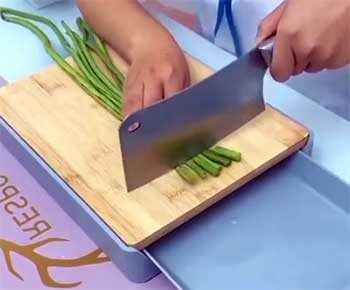
Acacia brings that warm, golden swirl to your counter—think rich patterns that scream artisan.
I’ve had an acacia board from a big-box store, thick and reversible, with a juice groove that handles roasts decently.
It feels premium at first glance, and the hardness keeps knife edges happy longer than softer woods.
You flip it for serving, and it doubles as a photo-worthy platter.
But here’s where Caraway pulls ahead for me. Acacia warps if you forget to oil religiously—leave it near the sink after a steamy pasta night, and the edges curl like a bad haircut.
My old one bowed after six months despite weekly oiling. Caraway’s birch stays flatter in humid kitchens; the FSC certification feels more transparent, too. Acacia sources vary—some sustainable, some sketchy.
Size-wise, most acacia boards come solo, usually 18×12 inches. Great for big jobs, but I miss the small and medium options when I’m just slicing a lime. Caraway’s trio lets me grab the right tool without clutter. The rack? Acacia leans against the wall or hides in a drawer—less airflow, more mildew risk.
Price stings on both: a solid acacia runs $60–$90, while Caraway’s set hits $195. You pay for versatility and storage with Caraway. If you love one statement piece, acacia wins on looks. For daily flow, Caraway organizes my chaos better.
- Caraway Compared To Yamato Cutting Boards
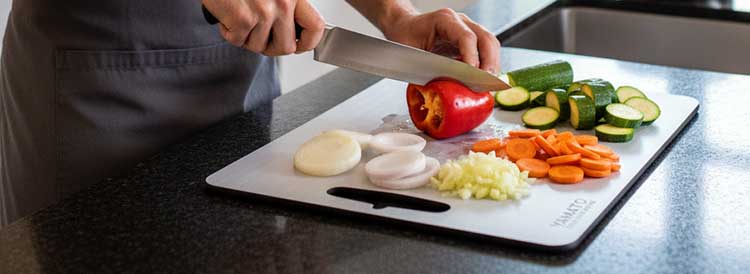
Yamato boards—those Japanese hinoki masterpieces—float into pro kitchens with a whisper. The cypress wood smells like a forest spa, and the softness cradles your blade like memory foam.
Chefs swear by them for sushi because the wood absorbs impact, keeping edges razor-sharp. I borrowed a friend’s 16×10 hinoki once; slicing salmon felt effortless, almost meditative.
Yet reality bites. Hinoki demands babying—oil after every use, store in a breathable bag, avoid direct sun. Skip a step, and it cracks like dry earth. My buddy’s board split down the middle after a dishwasher slip (his mistake, but tempting). Caraway’s birch forgives more—hand-wash, occasional oil, done.
Cost is brutal: a decent Yamato starts at $120 for a small board, climbing fast. Caraway’s full set feels like a bargain by comparison, especially with the rack included. Hinoki stains easily from beets or turmeric; Caraway’s mineral finish resists longer.
If you’re a knife nerd chasing that silky cut, Yamato edges out. For practical family cooking where boards get beat up, Caraway survives the storm.
- Caraway Compared To Beech Cutting Boards
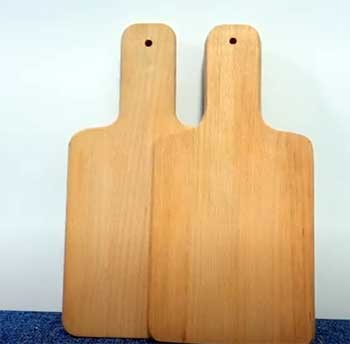
Beech hits that sweet spot of affordability and toughness—think European workhorse.
My parents still use a 20×15 beech slab from the ’90s; it’s scarred but solid, with end-grain construction that self-heals shallow cuts.
Restaurant supply stores sell them cheap—$40 for a beast that laughs at heavy cleavers.
Durability is beech’s flex. Drop a pan?
It dents, not shatters. Caraway’s edge-grain birch is gentler on knives but shows marks faster—after dicing onions nightly, faint lines appear. Beech hides battle scars better.
Maintenance overlaps: both need oiling, both hate dishwashers. But beech dries out and cracks without vigilance; I’ve sanded my parents’ board twice. Caraway’s wax-mineral combo beads water longer, buying you forgiveness.
Beech usually comes solo and thick—2 inches or more. Great stability, but lugging it for a quick sandwich? Nope. Caraway’s lightweight set rotates easily; the small board lives by the fridge for fruit duty.
Eco-wise, beech can be sustainable, but Caraway’s FSC stamp and no-plastic ethos feel cleaner. If budget rules and you want one tank, beech delivers. For organized, modern prep, Caraway’s system wins my vote.
Also Read: Is Chicago Cutlery Knife Set Worth It?
Frequently Asked Questions (FAQ)
Absolutely, if quality and peace of mind matter to you. The set’s versatility, non-toxic build, and knife protection make it a smart long-haul buy. Sure, the price bites initially, but it outlasts cheap alternatives, saving you replacements. In my daily grind, it’s streamlined prep like nothing else—worth every penny for safer, smoother chopping.
Yes, through and through. Crafted from FSC-certified birch wood with a food-safe mineral oil and wax finish, they’re free of plastics, BPA, BPS, and forever chemicals. No microplastics shedding into your food, and the natural antimicrobial properties keep things clean. I switched for health reasons, and it’s been a relief—no hidden nasties compromising my meals.
Gordon Ramsay favors thick, sturdy options like John Boos maple end-grain blocks—those massive 24-by-18-inch beasts that handle pro-level abuse. He loves their stability for precise cuts, often seen in his MasterClass demos. It’s old-school reliability, but if you’re home cooking, Caraway offers similar steadiness in a lighter, more accessible package.
Definitely— the birch wood’s antimicrobial nature fights bacteria naturally. Use the grooved side for juices, clean with hot soapy water or salt-lemon scrub right after, and air-dry upright. I do chicken and beef weekly without issues, as long as you maintain it. Just dedicate one board for meats to minimize cross-over risks.
Wrapping It Up: Make The Switch Today
There you have it—my no-holds-barred take on Caraway cutting boards after months of real-kitchen testing. From the seamless slices to the smart care that keeps them thriving, these boards aren’t just upgrades; they’re kitchen game-changers that make cooking feel less like work and more like a rhythm you enjoy.
Ditch the plastics, embrace the wood—your meals, health, and sanity will soar. Head over and snag the set; you won’t look back.
